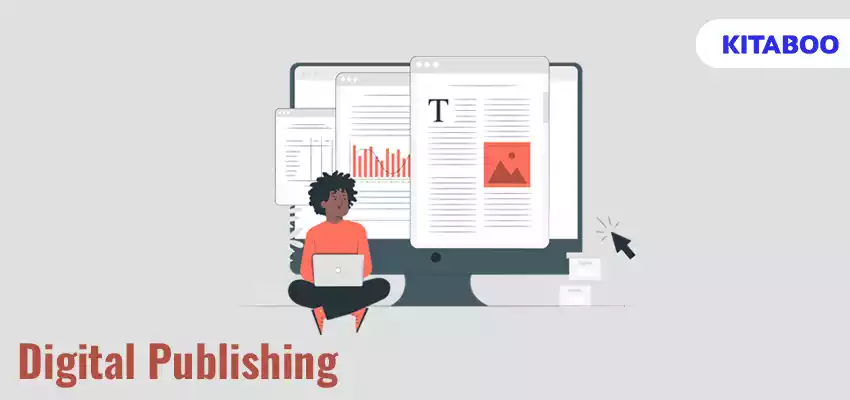
Revolutionizing Reading: The Global Impact on Digital Publishing
Summarize this blog with your favorite AI:
The recent rise in the number of digital publishing houses can be attributed to the increased popularity of digital reading.
Digital reading not only allows you to access a vast library of books at your fingertips but also provides several other advantages that establish digital publishing as a compelling and influential force in the literary landscape. These capabilities make digital reading a more immersive experience than physical books in many ways.
Read on as we take you through how reading has been revolutionized through digital publishing houses, highlighting the future innovations that are shaping the literary landscape.
Let’s start!
Table of Contents:
I. The Digital Revolution in Publishing
II. From Reading to Experiences: The Global Impact on Digital Publishing
- Enhanced Outreach
- Convenient Reading
- Personalized Experience
- Augmentations
- Integrated Experience
- Accessibility
The Digital Revolution in Publishing
In the 1990s and 2000s, online content became extremely popular. There were PDF versions of books available online to read. They were not as costly as their printed counterparts; some versions were available free of charge to download.
The launch of the Amazon Kindle changed the digital reading landscape completely. Books were no longer a print-exclusive item. Readers could carry them all at once as a digital book on a single, lightweight device.
Kindles, with their capacity to store hundreds of books, revolutionized how students carried course materials and how avid readers traveled with their favorite literary companions. Subsequent innovations have paved the way for multimedia-enabled interactive content in eBooks, creating a reading experience so immersive that it engages multiple senses.
Today, digital reading is not limited to a specific device, eliminating previous barriers to book accessibility and facilitating widespread knowledge dissemination among the masses.
From Reading to Experiences: The Global Impact on Digital Publishing
As the digital publishing niche evolves and grows, it has a significant impact on reading habits and all associated aspects of the ecosystem.
Here are six major ways this global impact on digital publishing can be seen in 2024:
Enhanced Outreach
Digital publishing houses actively invest in technologies that help them improve the outreach of their publications. They leverage a variety of eBook formats (such as EPUB, BBeB, DjVu, etc.) for their publications so that they can be viewed across different eBook readers and online platforms.
Additionally, social media empowers publishing houses to ramp up their marketing and public outreach across diverse online channels, bringing more readers to their eBooks.
Convenient Reading
Readers get the benefit of convenience by consuming digitally published content. They get access to hundreds of titles using just a single login ID and password for an eReader app or platform.
Digital books are available for access through mobile phones, empowering readers to carry several titles for offline reading wherever they go. Adaptive technologies have made it more convenient for readers to read digital content easily, even on smaller screens.
Personalized Experience
The key transformation that has emerged through digital publishing is that of personalization. Readers can now use eBook reading platforms as a standalone apps that they can personalize according to their preferences.
Digital textbook platforms like KITABOO are equipped with smart recommendation engines that understand user preferences and bring more similar content to their screens. It helps make exploration easier without compromising on choices.
Augmentations
Digital reading platforms provide users with several augmentative features, like creating personalized libraries and collections. Readers can create their own “digital shelf” with custom labels and organize it in the way they prefer.
Additionally, it is also possible to host group reading on some eReader platforms. Group reading features support note sharing, annotations, and even collaboration on the platform for digital books. Such features are especially helpful for K-12 and online learning platforms.
Integrated Experience
Digital reading has enabled integrated experiences for readers through features like social sharing. Such features enable readers to plug other services into the reading platform and make cross-operation easier.
For example, digital textbook platforms like KITABOO can be integrated with digital classroom systems to facilitate enhanced digital learning.
Several other integrations are possible with digital publishing, for example, integrating dictionaries with eReader platforms to make comprehension simpler.
Accessibility
Digital reading enables readers to apply several ease-of-reading features to make the whole experience even better. For example, the read-aloud feature in digital publishing helps people with reading difficulties understand the content.
Other augmentative features like screen contrast, brightness, and backlight, text size, screen readers, etc., are only possible with digital books.
Compared to traditional reading, digital publications are more inclusive and accessible. This inclusivity is due to the myriad features and customization options that cater to diverse reading needs.
Exploring The Future of Reading
Digital publishing houses will continue to innovate and transform reading further into the future.
Here’s a snapshot of the future trends and innovations:
- Digital publishing is expected to completely transform knowledge delivery in educational systems by integrating student learning into digital spaces.
- Students would use digital textbooks to not just read but also annotate, share, and collaborate in real-time with each other over the school network and resources.
- The future of digital reading extends to collaborative learning environments. Students will engage not only in reading but also in real-time interactions, discussions, and shared annotations, boosting a dynamic and collaborative educational experience.
- In vocational and practical education, digital reading takes on a crucial role. Particularly in fields like healthcare training, immersive digital experiences using AR, VR, and AI-based learning will provide in-depth insights into subjects like human anatomy, offering practical and hands-on learning opportunities.
KITABOO: New Reading Experiences
Reading is no longer confined to turning pages; it’s an immersive encounter, a blend of convenience, accessibility, and sheer pleasure.
In the realm of digital publishing, constant innovation is the key to harnessing modern technologies to redefine the reading landscape.
KITABOO, a leading digital textbook platform, enables readers to benefit from a comprehensive, secure, and productivity-equipped reading platform.
With this platform, publishing houses can leverage an end-to-end toolset to create, enrich, publish, distribute, and license digital eBooks. KITABOO also provides distribution and licensing control to the creators, providing airtight administrative rights.
Connect with our team today to get started!
Also check:
Discover how a mobile-first training platform can help your organization.
KITABOO is a cloud-based platform to create, deliver & track mobile-first interactive training content.



![Top 5 Free Publishing Sites for Independent Publishing [2026]](https://kitaboo.com/wp-content/uploads/2025/09/Top-5-Free-Publishing-Sites-for-Independent-Publishing-2026-420x235.webp)